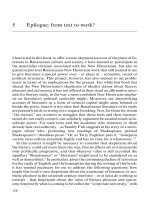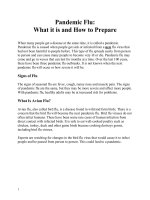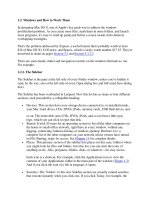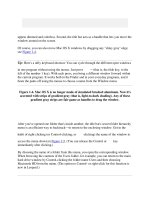Creative industries, flexibility, and travel to work
Bạn đang xem bản rút gọn của tài liệu. Xem và tải ngay bản đầy đủ của tài liệu tại đây (157.71 KB, 16 trang )
School offorsomething
Institute
Transport Studies
FACULTY
Faculty
of Environment
OF OTHER
Creative Industries, Flexibility, and
Travel to Work
Julian Burkinshaw
ITS Summer Seminar Series
16th June 2015
Introduction
My background and interests:
• 2nd year PhD Student
• Graduate from the University of Salford
• Undergraduate dissertation focussed upon a Workplace Travel Plan
• Interests in commuting, travel to work, working practices, flexibility
Introduction
• The story so far…
• Creativity and Creative Industries
• Fixity and Flexibility
• Theory and conceptualisation
• Questions and hypotheses
• Approach
The story so far…
• Workplace travel planning
• The Commute
• Backcasting/future of commuting
• Global Perspectives
• My approach…
Creativity and Creative Industries
‘The key to economic growth lies not just in the ability to attract the ‘creative
class’, but to translate that underlying advantage into creative economic
outcomes in the form of new ideas, new high-tech businesses and regional
growth’
(Florida, 2002. p.2).
‘…it seems as if human capital, especially the ability to handle large amounts of
information and to come up with bright ideas, has surpassed financial capital, raw
materials, and labour in general as the key resources for economic progress’
(Bontje and Musterd, 2009. p.843).
Creativity and Creative Industries
The concept of creative industries emerged in the late 1990s primarily as a
policy discourse, …its origins can be traced to the decision of the then newly
elected British Labour government of Tony Blair to establish a Creative
Industries Task Force (CITF), as a central activity of its new Department of
Culture, Media and Sport (DCMS).
(Flew and Cunningham, 2010. p.113).
‘Creative work facilitates autonomy and flexibility, with informality and diversity
seemingly regarded as key characteristics of the creative workforce’
(Henry, 2009. p.149).
Working practices
Flexible working practices have become an increasingly popular initiative within
many organisations, with the merits and disadvantages associated discussed at
length within the literature:
•
•
Work-life balance discussions
in women participating in labour market
•
Intensification of work
•
Blurred boundaries between home and work
•
Job satisfaction and quality
Fixity and Flexibility
There is a lack of consensus over what flexible working actually is!
For instance, these concepts are visible in the literature:
•
•
•
•
•
Schedule Control
Flexible work practices
Flexible work arrangements
Job Control
Job Autonomy
‘transportation geographers commonly denote activities as fixed or flexible on the
basis of their purpose or type. Roughly speaking, paid employment, education,
sleep, and transporting children or other persons are considered fixed, and
shopping and leisure are regarded as flexible’
(Schwanen, Kwan and Ren, 2008. p.2110).
The Role of Responsibility
Responsibilities, mainly those associated to the household, have interesting effects
on the way people travel to work. For example:
• Residential location
Amongst which, residential environment often prevails over travel mode preference
(Schwanen and Mokhtarian, 2005).
• The presence of children in the household
Findings were associated to gendered differences in commuting times (McQuaid and
Chen, 2012).
Theory and conceptualisation
Social practice:
Social practice theory pertains that people (as practitioners) when doing things like
walking, driving or cooking, and in the case of this research; working, they actively
combine elements from which the practices are made (Shove et al., 2012).
These elements are Materials, Competences and Meanings.
It is anticipated that through discussions of participants’ ‘everyday practices’
regarding work, travel and responsibilities, insight into how and why these are
produced will be explored. Hopefully this approach will identify avenues for travel
demand reduction through practice reconfiguration.
Theory and conceptualisation
Creative industries/occupations
=
↑ opportunities in flexibility
↑ opportunities in flexibility
=
↓ travel demand / ↑ lower carbon
Questions and hypotheses
How work is structured has an important impact on how people travel to
work
Those with greater flexibility in determining their own working practices
have greater potential to be flexible with how they travel to work
Where there is greater possibility for flexibility, reducing overall travel
demand and/or choosing lower carbon options are contingent on a
multitude of factors, namely (household) responsibilities and activities
Questions and hypotheses
1. Does the structure of work have important impacts on daily
schedules?
2. In what ways does flexibility influence travel to work?
3. How do (household) responsibilities influence travel to work
decisions, and for whom are these decisions most impacting?
4. What would be required to reduce overall travel demand and/or lead
to an increase use in lower carbon options?
Approach
Design
• Comparative Case-study
• Purposive Sampling
• Architects vs Accountants
• SMEs
Methodology
• Two semi-structured interviews
‘The experience of these SMEs showed that a greater degree of genuine
flexibility is possible in the small-scale context where relationships are
understood and working conditions are clear and visible’. (Dex and Scheibl, 2001.
p.411)
Questions and hypotheses
Thank you for you attention
Any Questions?
Approach
References:
BONTJE, M. & MUSTERD, S. 2009. Creative industries, creative class and competitiveness: Expert opinions critically
appraised. Geoforum, 40, 843-852.
DEX, S. & SCHEIBL, F. 2001. Flexible and family-friendly working arrangements in UK-based SMEs: business cases.
British Journal of Industrial Relations, 39, 411-431.
FLEW, T. & CUNNINGHAM, S. 2010. Creative industries after the first decade of debate. The information society, 26, 113123.
FLORIDA, R. 2002. The Rise of the Creative Class Cities without gays and rock bands are losing the economic
development race. Washington Monthly, 34, 15-26.
HENRY, C. 2009. Women and the creative industries: exploring the popular appeal. Creative Industries Journal, 2, 143.
MCQUAID, R. W. & CHEN, T. 2012. Commuting times – The role of gender, children and part-time work. Research in
Transportation Economics, 34, 66-73.
SCHWANEN, T., KWAN, M.-P. & REN, F. 2008. How fixed is fixed? Gendered rigidity of space–time constraints and
geographies of everyday activities. Geoforum, 39, 2109-2121.
SCHWANEN, T. & MOKHTARIAN, P. L. 2005. What affects commute mode choice: neighborhood physical structure or
preferences toward neighborhoods? Journal of Transport Geography, 13, 83-99.
SHOVE, E., PANTZAR, M. & WATSON, M. 2012. The dynamics of social practice: everyday life and how it changes,
Sage.









